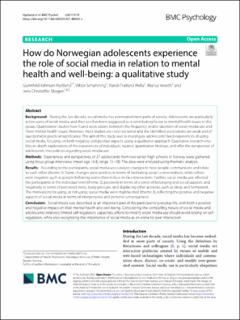| dc.description.abstract | Background
During the last decade, social media has permeated most parts of society. Adolescents are particularly active users of social media, and their use has been suggested as a contributing factor to mental health issues in this group. Quantitative studies have found associations between the frequency and/or duration of social media use and more mental health issues. However, most studies are cross-sectional and the identified associations are weak and of questionable practical significance. The aim of this study was to investigate adolescents’ lived experiences of using social media, focusing on both negative and positive aspects, using a qualitative approach. Qualitative research enables in-depth explorations of the experiences of individuals, nuance quantitative findings, and offer the perspective of adolescents into policies regarding social media use.
Methods
Experiences and perspectives of 27 adolescents from two senior high schools in Norway were gathered using focus group interviews (mean age 16.8, range 15–18). The data were analysed using thematic analysis.
Results
According to the participants, social media use catalyse changes to how people communicate and relate to each other (theme 1). Some changes were positive, in terms of facilitating social connectedness, while others were negative, such as people behaving worse than in face-to-face interactions. Further, social media use affected the participants at the individual level (theme 2); positively in terms of a sense of belonging and social support, and negatively in terms of perceived stress, body pressure, and displacing other activities such as sleep and homework. The motivations for using, or not using, social media were multifaceted (theme 3), reflecting the positive and negative aspects of social media in terms of interpersonal and personal consequences.
Conclusion
Social media was described as an important part of the participants’ everyday life, with both a positive and negative impact on their mental health and well-being. Considering the compelling nature of social media and adolescents’ relatively limited self-regulatory capacities, efforts to modify social media use should avoid relying on self-regulation, while also recognizing the importance of social media as an arena for peer interaction. | en_US |

